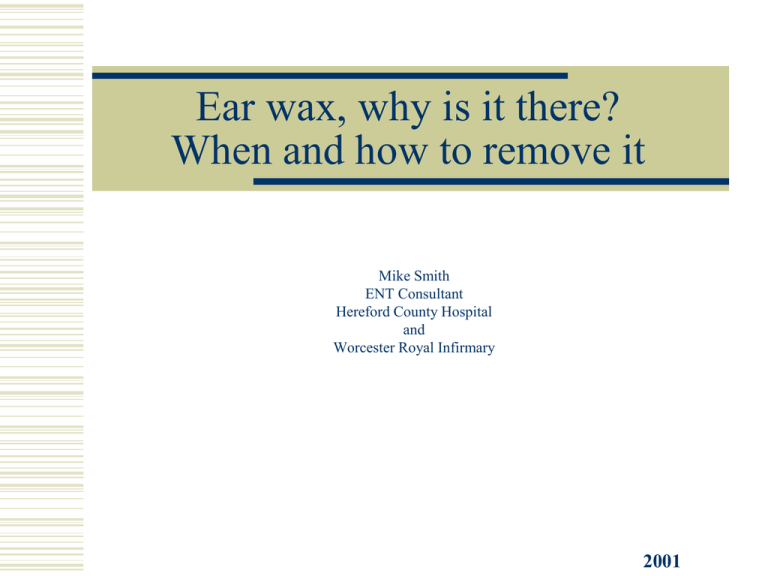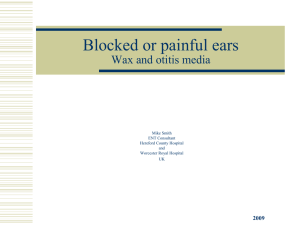Anatomy: Ear Canal 2-3cm long (2.7 avg.)
advertisement

Ear wax, why is it there? When and how to remove it Mike Smith ENT Consultant Hereford County Hospital and Worcester Royal Infirmary 2001 Anatomy: Ear Canal: 2-3cm long (2.7 avg.) Cartilaginous part Bony part Outer 1/3 of canal Inner 2/3 of canal Skin Thick, 1.5-2mm Thin, 0.1-0.15 mm Glands 1. Cerumen 2. Sebum None Hair 1. Fine 2. Thick (older men) None Ear Canal Glands and Wax Cerumen Long coiled tubes with muscle walls. In hair follicles. Secrete like sweat in response to e.g emotions like fear. Thin sweat like secretion. Sebum Secrete Oily fluid. In hair follicles. Epithelium Migrated from deep canal and from drum surface. Hairs Shed and matting with secretions. Functions of wax Waterproofing layer Protective layer from trauma Migration outward with dust, foreign material (e.g.sand, grommets) pH is antiseptic Contains antibacterial agents Canal Skin Migration Epithelium Keratin/ dead skin moves from drum centre out and along canal to meet the secretions in outer canal Wax formation: Mixed cerumen, sebum, epithelial debris and loose hairs Keratosis Obturans Failure of migration. Epithelial build up and canal expansion. Rare. Remedies and folklore Historical Ancient Egypt syringing with olive oil, frankincense, salt Also reported goat’s urine, steam Wax spoons Ear ‘candling’ Harmful practices: Scratching Cotton buds False conceptions: Wax is dirty in some way Wax is often the cause for reduced hearing Problems with wax? Hearing loss Totally obstructed e.g. wax and water (conductive hearing loss 45dB) Apparent total obstruction (hearing loss 5dB) Non-obstructive (no loss) Tinnitus Crackling due to contact of wax in canal with drum Associated with hearing loss of canal obstruction Pain, Otitis Externa Hearing aid obstruction Treatment options Solvent drops Syringe Aural speculum and loops/hooks Microscopic suction Wax Solvent Drops Bicarbonate Olive oil Glycerine Commercial e.g. Cerumol, Waxsol, Exterol (5% urea / peroxide in glycerol) Ear Syringing Types of syringe Metal, traditional Plastic Rubber bulb/rat-tail Electrical pulsed pump Method (training?) Solvent for 1/52 beforehand Straighten canal (Pull up and back) Water at 37-38 deg. C Smooth action syringe Brace nozzle with hand on head, against sudden movement Plastic drape on patient Point syringe up and back After syringing check canal/drum (Dr?) Survey of GP practice BMJ Sharp et al. 1990 312 GPs, (289 responders) 274 do syringe (20% always do it themselves) 44,000 ears syringed in period of study (9 pts. per GP per month) Even when wax appeared to be obstructive; mean hearing gain was only 5dB. Risks of syringing A New Zealand Med Insurance group reported 25% of claims arise from ear syringing. Complications requiring specialist referral in 1:1000 Indications for syringing Total occlusion Pain / discomfort Examination of obscured tympanic membrane Tinnitus (but may aggravate) Otitis Externa ( if other cleansing not available) Foreign body Contra-indications to syringing Non-occlusive wax (be more selective of patients) Previous ear disease with atrophic thin drum Previous ear surgery (even grommets can leave thin segments of drum) Awaiting ear surgery (can precipitate mastoiditis) Perforation (may force debris into middle ear or reinfect the perforation) Only hearing ear (take no risks) Past history of recurrent Otitis Externa Extra care to avoid trauma if taking anti-coagulant Atrophic drums Rupture of human ear drum by syringing Study by Sorenson et al 1995 10-48 hr cadavers Measured ear canal pressures Large variations in rupture pressure, but well above that generated by syringing (if TM not atrophic) Least risk: Young Narrow canal No atrophic sections of TM Higher risk: Older Wide canal Straight canal Thin TM Rupture pressures using rubber bulb syringe Rupture pressures using plastic ear syringe Rupture pressures using metal ear syringe Rupture pressures of thin, atrophic drum Rupture pressures of normal drum Experimental rupture pressures of Tympanic membrane 1600 1400 1200 1000 800 600 400 200 0 Maximum (mm Hg) Minimum (mm Hg) Treatment of complications Otitis externa Acute sensori-neural prompt treatment hearing loss or vertigo refer if canal occluded by Urgent referral debris or oedema Refer early if in any Perforation doubt. specialist referral Do not blindly reassure the (it usually heals) patient, check Canal wall bleeding bicarbonate or a/b drops stat follow up to ensure clot clears Removal of wax with instruments Lighting: Suction Open head otoscope Varying sizes of microHeadlight sucker, Ear Microscope best done using operating microscope, (Microsuction) Speculum occasionally GA required On otoscope or Tools: handheld Wax loop (Billeau’s) Ring probe (Jobson-Horne) Wax hook







